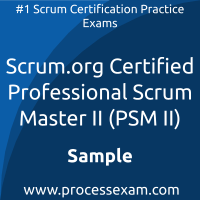01. When should the Product Owner cancel a Sprint?
a) When the Developers determine that the Product Goal is unattainable
b) When the Sprint Goal becomes obsolete
c) When the CEO has a new business opportunity
d) When it becomes clear that not all the Sprint Backlog can be Done by the end of the Sprint
02. Who is responsible to inspect progress toward the Sprint Goal?
a) The Project Manager
b) The Scrum Master
c) The Developers
d) The Product Owner
03. Which of the following is an indicator that a Scrum Team is cross-functional?
a) The Scrum Team has all the skills necessary to create value each Sprint.
b) Each member of the Scrum Team is T-shaped
c) The Scrum Team members are good friends
d) Each member of the Scrum Team has all the skills necessary to create value each Sprint
04. The Sprint Backlog is updated throughout the Sprint as more is learned. However, when should it be updated?
a) Whenever the Product Owner identifies new work to be added to the Sprint Backlog
b) Whenever the Scrum Master is available to update the artifacts
c) As soon as possible, after the update is identified
d) During Daily Scrums
05. You are working with a product which as performance as a key requirement. The manager of a Scrum Team which has you as the Scrum Master suggests to you that performance testing should only be performed every other Sprint because it is too costly. He wants to know your opinion.
What would you say?
a) It depends on what is stated in their Definition of Done.
b) It is not a good idea, because the Increment will lose transparency, making the feedback longer than need, and hindering empiricism.
c) It is a good idea, because we could save money.
d) Performance testing is not necessary for a product, and the team should focus solely on functional requirements to save time and effort.
06. During a Sprint Review, a key stakeholder points that the budget for the project was reduced given external factors. Given this, an emotional argument follows. As a Scrum Master, what is your best option?
a) Ask for a short break for people to calm down and be objective.
b) Encourage the stakeholders to keep getting more work for the Scrum Team, so that they are busy.
c) Argue that the budget cannot be reduced and that additional funding must be provided.
d) Let the Product Owner handle the matter, since he is responsible for the Sprint Reviews.
07. When must an Increment be released?
a) At the end of each Sprint
b) Whenever there are no identified defects
c) Whenever it is created.
d) Whenever the Scrum Team judges that a release is valuable
08. Why is the Sprint Goal useful for the Developers?
a) Gives them the drive they need to get done with all the Product Backlog items selected for the Sprint
b) It gives them a shared and specific target
c) They are not as valuable as the Product Goal
d) It sets a target for Sprint 0
09. What happens to undone work at the end of the Sprint?
a) The Sprint length keeps as is and the Scrum Team uses the opportunity to learn and adapts
b) The Scrum Team has 2 days to get done with whatever is left.
c) The Sprint is extended and the issue is discussed in the Sprint Retrospective
d) The Scrum Team ignores the undone work and starts a new Sprint without any consideration for the unfinished items.
10. You are the Scrum Master of a Scrum Team from an organization that is known to consider on-time delivery and reliability very seriously. A manager detected that your team is not up to speed and that it should increase velocity by 15%. He came to you, the Scrum Master, expecting you to make it happen. How do you respond?
a) You tell the manager to talk to the Product Owner since she is the person responsible for having accurate forecasts.
b) You present this challenge as a company goal for the Scrum Team while leaving them responsible to define how to achieve it.
c) You explain how a Scrum Team uses velocity as a forecast for the work to be done next Sprint but as a prediction of future productivity. Further, you encourage the manager to communicate with the Product Owner for information about the product development progress.
d) You teach the manager that the velocity only concerns the Scrum Team but invite him to participate in the Sprint Retrospective to help the team improve.
 You have to pass the PSM II exam to receive the certification from Scrum.org. To increase the effectiveness of your study and make you familiar with the actual exam pattern, we have prepared this Scrum.org Professional Scrum Master sample questions. Our Sample Scrum.org Professional Scrum Master II Practice Exam will give you more insight about both the type and the difficulty level of the questions on the Scrum.org PSM 2 exam.
You have to pass the PSM II exam to receive the certification from Scrum.org. To increase the effectiveness of your study and make you familiar with the actual exam pattern, we have prepared this Scrum.org Professional Scrum Master sample questions. Our Sample Scrum.org Professional Scrum Master II Practice Exam will give you more insight about both the type and the difficulty level of the questions on the Scrum.org PSM 2 exam.